Mad Hedge Technology Letter
September 1, 2023
Fiat Lux
Featured Trade:
(BEST BUY PUTS IN A SHIFT FOR TECH)
(BBY), ($COMPQ)

Mad Hedge Technology Letter
September 1, 2023
Fiat Lux
Featured Trade:
(BEST BUY PUTS IN A SHIFT FOR TECH)
(BBY), ($COMPQ)

When interest rates go from zero to 5%, fundamentals tell investors that tech stocks are the most likely to drop.
This was an ironclad rule of the market for centuries until it wasn’t.
In 2023, tech stocks ($COMPQ) continue to climb a wall of worry with this fantasy deriving from the Fed is about to “pivot” narrative.
Traders still believe that the Fed is going to turn around and slam the breaks on this quantitative tightening cycle to breathe life into the economy.
Tech stocks and bond yields going up in tandem is highly rare and the Mad Hedge Technology Letter was able to catch the wave of excitement in the first half of the year.
The Fed pivot is based on people with money believing the Fed will just bail out the whole stock market once things go sour.
Hence, the good news is the bad news paradigm we keenly observe in tech stock price action.
Another data point dropped in the tech market with retailer Best Buy delivered its earnings report.
They issued another unspectacular report with a lowered outlook.
For many tech companies, the lockdown sales will never go back to 2021.
I feel like a broken record here because tech earnings are doing just enough to hop over the low bar. Best Buy (BBY) is just another one of emblematic of tech performance today.
Comparable sales, a key metric that includes sales online and at stores open at least 14 months, decreased 6.2% compared with the year-ago period as customers bought fewer appliances, home theaters, and mobile phones. Gaming systems, on the other hand, were sales drivers in the quarter, the company said.
Best Buy is seeing a reversion to pre-lockdown sales levels analogous to Home Depot and Lowe’s, Best Buy profited from lockdowns, fueled by big purchases that people don’t frequently repeat.
Over the past year, consumer electronics retailers have borne the brunt of disastrous Bidenflation and consumers’ shift back to spending on experiences.
Management said the company is on track with its brick-and-mortar plans for the fiscal year. The company plans to close 20 to 30 stores, remodel eight stores to turn them into more experiential shops, and expand outlet stores from 19 to about 25.
The past 2 weeks have reverted back to the tech bulls as they pull us back from the latest weakness in July.
It’s almost getting comical at this point that we are inching back to all-time highs when so many tech companies aren’t doing anything special in terms of not only growth but negative revenue trajectory.
This isn’t the stuff of legends and in a normal world, these aren’t the type of earning reports that fuels bullish price action.
However, since the Fed is perceived as bail-out trigger-happy, investors are juicing up the stock market based on this hope that the Fed will reroute rates back to 0% when the economy needs to be saved. As long as this counter-intuitive narrative persists and tech companies don’t deliver ugly earnings, the pain trade is ostensibly higher. Welcome to the world where Best Buy does -6% sales, iPhone sales sink, yet we go higher and higher.
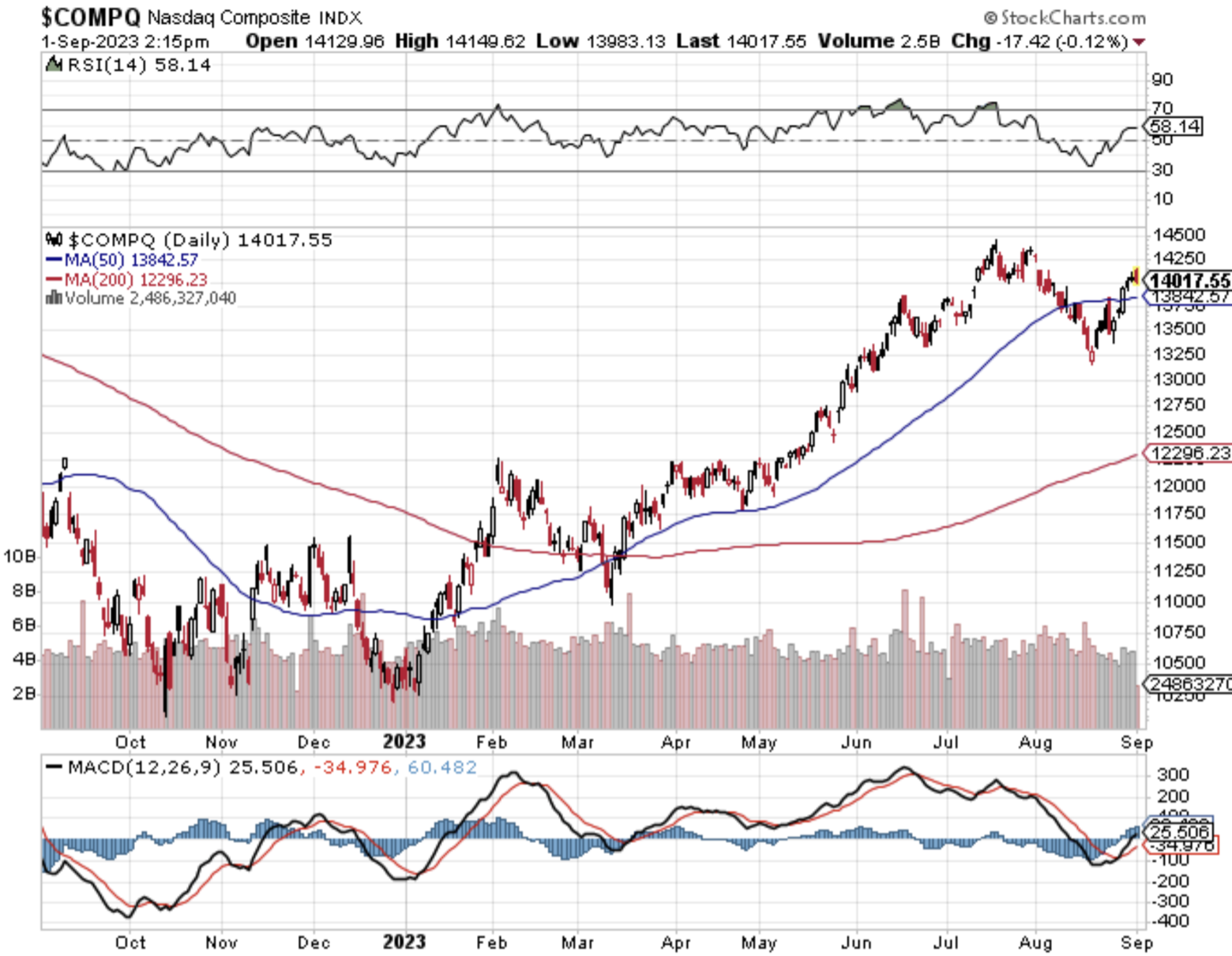
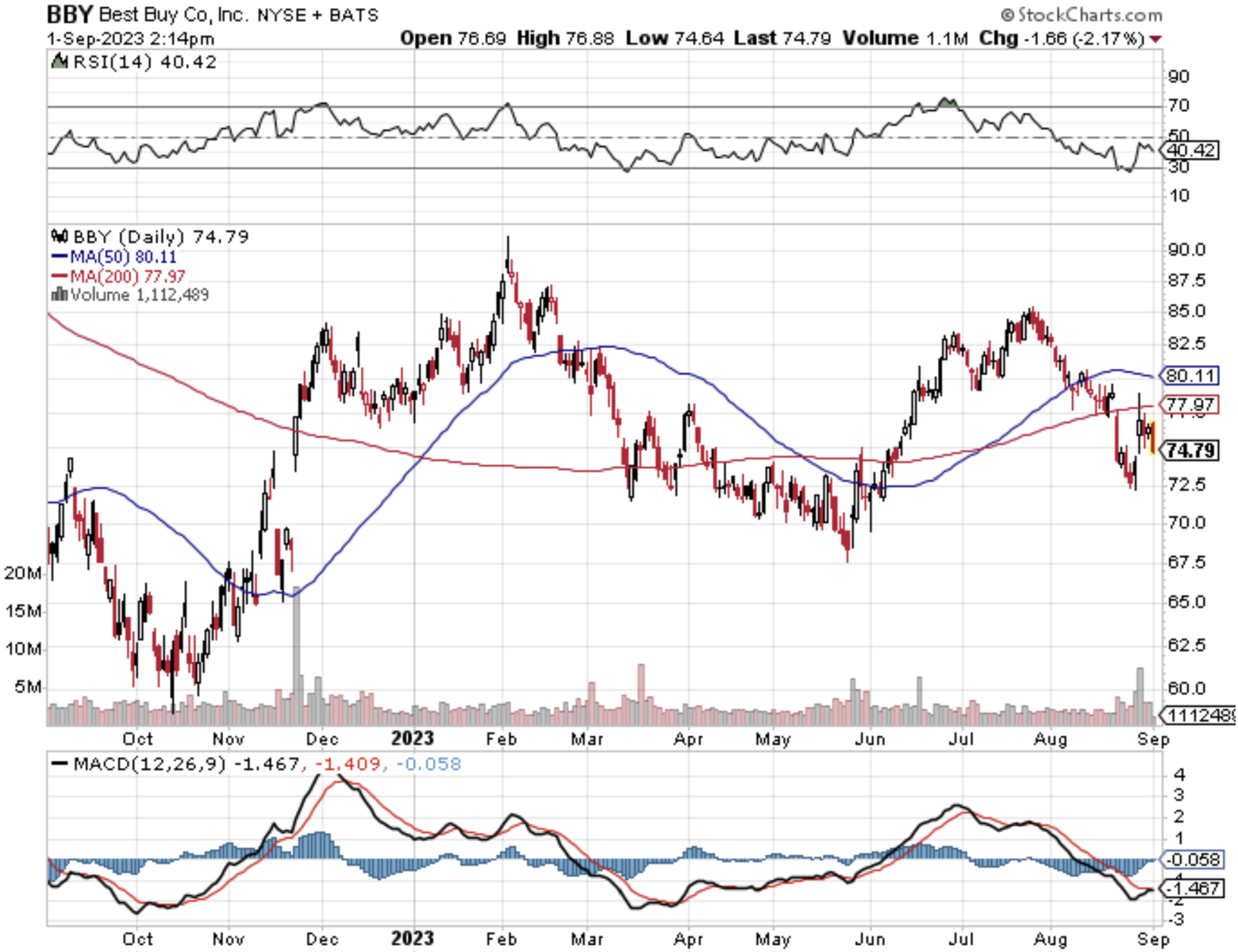
Mad Hedge Technology Letter
August 30, 2023
Fiat Lux
Featured Trade:
(BULLISH SIGNS FOR 2024)
(AMZN), (GDP), ($COMPQ)

In a fireside chat with some of Amazon’s (AMZN) key lieutenants, CEO of Amazon Andy Jassy ran out of patience.
It’s the end of the line for many.
Critical members of Amazon are still holding onto the rose-colored fantasies of the lockdown era, where workers made their living wearing pajamas all day and took snoozes whenever they wanted.
Not anymore was the message from Jassy.
Enough is enough.
Employees usually don’t have the 30,000-foot view that executives like Jassy have even if they pretend to sometimes.
The paradigm has shifted to the point where management wields all the bargaining power as tech companies trim the fat off their business model.
This spat epitomizes where we are right now in the tech cycle and the wider US economy as a whole.
Tech ($COMPQ) is in a holding pattern where the biggest and best are utilizing a strong balance sheet, but they aren’t doing something so amazing where we chase the hot money with more hot money.
Ironically enough, the US GDP annualized rate just got revised down from 2.4% to 2.1% as spiking interest rates and high inflation eat into growth.
Although companies like Amazon are still doing ok, it’s not to the point where key members of staff can lounge in their sleeping gowns and work one hour per day.
There is resistance from higher management demanding Amazon workers come back to the office.
The deeper underlying message here is that the US economy is still growing buoyantly enough and that signals strength going into 2024 for tech stocks.
There is a better than 50% chance that the US economy won’t enter a recession next calendar year and the tech sector will benefit as it grinds higher.
An important trend I have noticed is that tech shares can absolutely march higher in lockstep with accelerating bond yields.
Many believed this was counterintuitive and I admit, traditional orthodoxy has taught us to respect this inverse correlation.
However, this time-honored belief has come unstuck this year and fighting the Fed has been the tech trade of the year.
What’s next for Amazon?
This is a stark change from February this year when Jassy said he had "no plan" to force workers back.
But now, Jassy reportedly reiterated a rhetoric that has emerged in more recent months: don't comply with return to office, face the consequences.
In July, Amazon employees would be forced into a "voluntary resignation" if they refused to return unless they were one of the rare few who had obtained permission from the company's leadership—internally named the S-team.
Former Twitter CEO Elon Musk was the first tech executives who started this fad by firing 80% of Twitter’s staff when he acquired the company.
That philosophy has really gutted the bottom of the chain in tech companies and shares of tech firms will benefit from this through 2024.
Instead of paying for expensive workers to sit at home, tech management are summoning up shareholder returns in the form of dividends and share buybacks to extend the tech bull market to the end of 2024.
I am still bullish tech stocks moving forward and algos are still programmed to bet on a Fed pivot. Tech goes up until the Fed pivots.
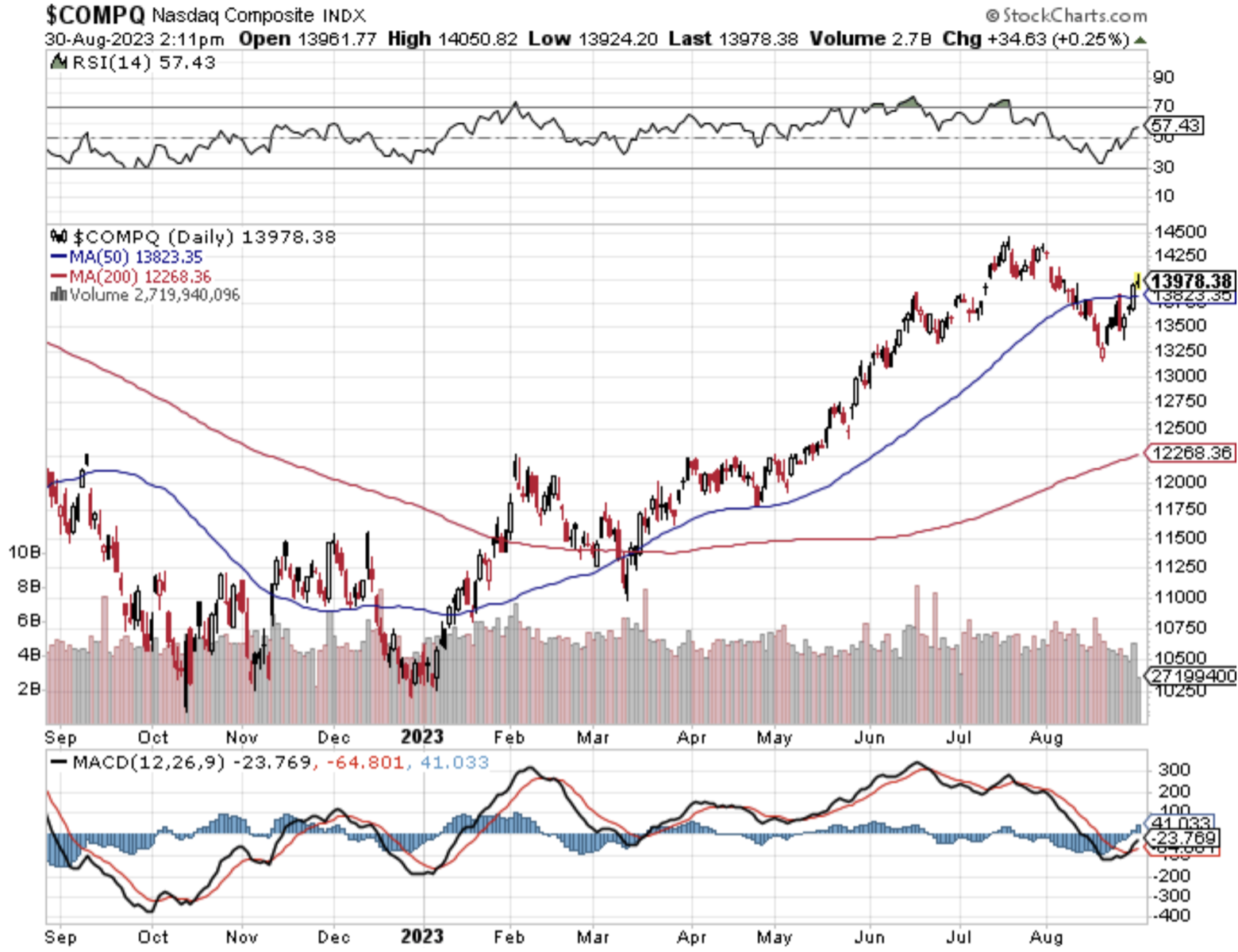
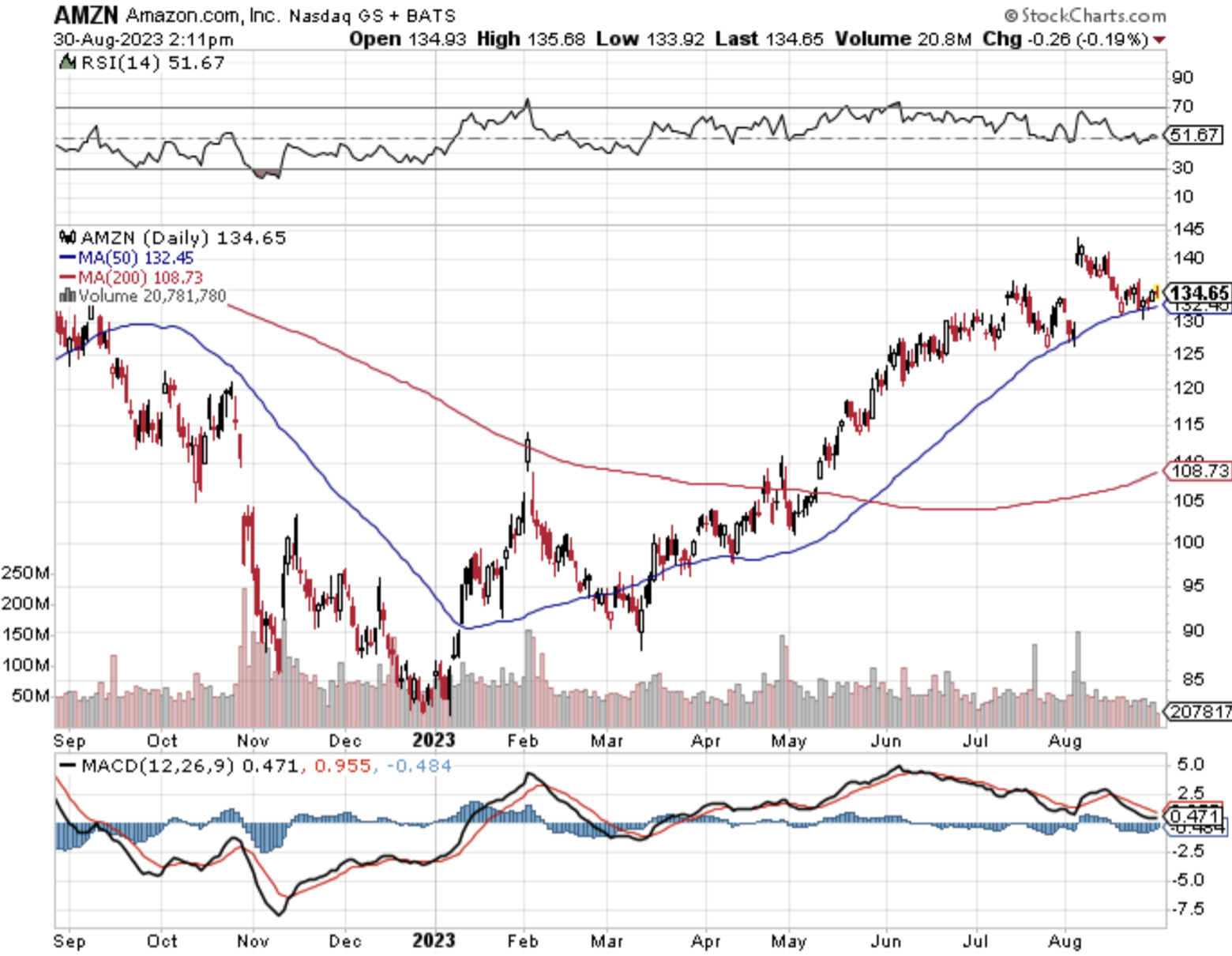
Mad Hedge Technology Letter
August 25, 2023
Fiat Lux
Featured Trade:
(ANOTHER LOW BLOW FOR TECH)
($COMPQ), (NVDA)

The almost four-year “transitory inflation” is a stark reminder that it isn’t smooth sailing yet for tech stocks ($COMPQ) after a glorious first 7 months of the year.
In hindsight, it appears more and more as if the great outperformance of the first 7 months in tech stocks was mainly due to a mean reversion after 2022 another surge helped by Nvidia’s (NVDA) AI hype.
The last 4 months of the year don’t appear as if these two tailwinds will light rocket fuel under tech stocks.
It’ll be harder to make money without those two turbo boosters.
Today tech got even more bad news as Federal Reserve Chair Jay Powell said the central bank is "prepared to raise rates further."
The hurtful part of this for tech stocks is that Powell’s comments absolutely have a knock-on effect to tech products.
Who wants to add that extra layer of anti-viral software protection when the budget is tight?
Powell is narrowing the goalposts for tech companies.
Which Tick-Tock influencer is going to re-up to the better iPhone when they can’t afford it?
According to Reuters, Americans are now paying around $800 per month extra for the same daily necessities they paid for before March 2020.
That is $800 that could possibly go into more tech hardware and software that isn’t.
Powell doubled down on crushing inflation saying it is the “Fed's job to bring inflation down to our 2 percent goal, and we will do so.”
Right away we saw Fed futures expectations adjust to this new information with the “higher for longer” mantra taking hold in reality.
The consensus is now that the first rate cut will be sometime in the summer of 2024 of .25%.
Traders should remember that the first rate cut was priced in at the end of this year just recently.
The Fed has gotten more hawkish lately and that is demonstrably negative for the short-term trajectory of tech stocks.
In 2023, accelerating US economic growth of 2.4% has presented a challenge to the Fed on several levels, with the Fed chair noting the overall economy "may not be cooling as expected."
And the strength of the labor market has been at the center of this challenge.
While monthly job gains have cooled through the summer, Powell said Friday the labor market's rebalancing "remains incomplete."
In turn, wage pressures have moderated.
The Fed really has two problems on its hands as it seeks to induce a recession – full employment and blistering economic growth.
The fact is that the stock market and the economy have handled these itty bitty .25% interest hikes gracefully.
That would hardly be the case if rates were hiked 5% at one time.
Businesses have had time to adjust to the new normal and so has the tech industry by firing a swath of ineffective employees.
The net result of this is bad for technology stocks in the short term, but staving off a recession is also in the interest of the tech sector as well.
I expect tech firms to keep shedding the fat off their business model as we barrel into sink-or-swim times.
There won’t be excess money sloshing around in the system for the foreseeable future and tech bankruptcies should rise.
That doesn’t mean tech stocks will crater, but it does mean many business models need to consolidate before another move up.
The real weak hands will finally get flushed out.
Tapping the debt market because of poor management decisions is now route one to bankruptcy and that hasn’t been the case in technology companies for a long time.
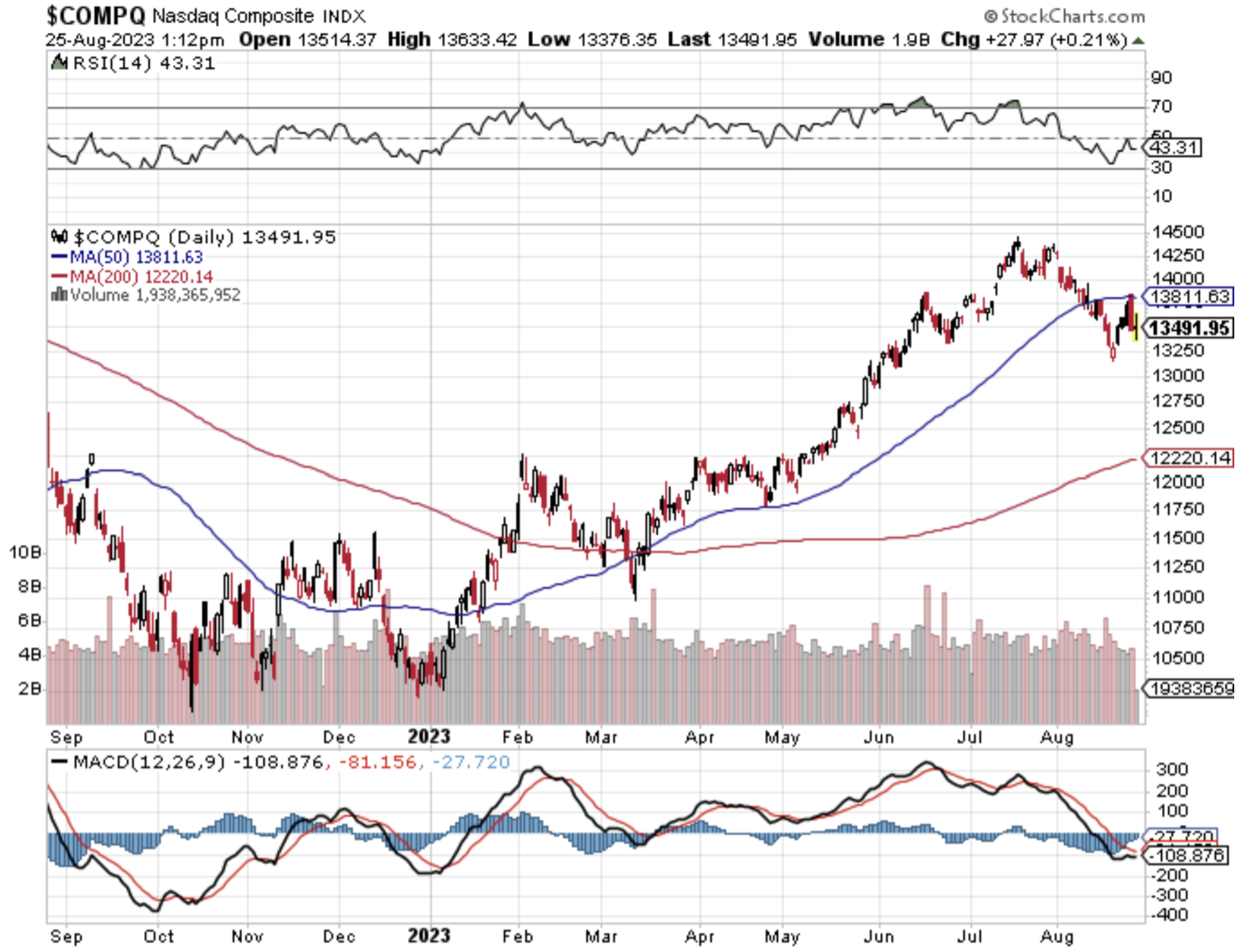
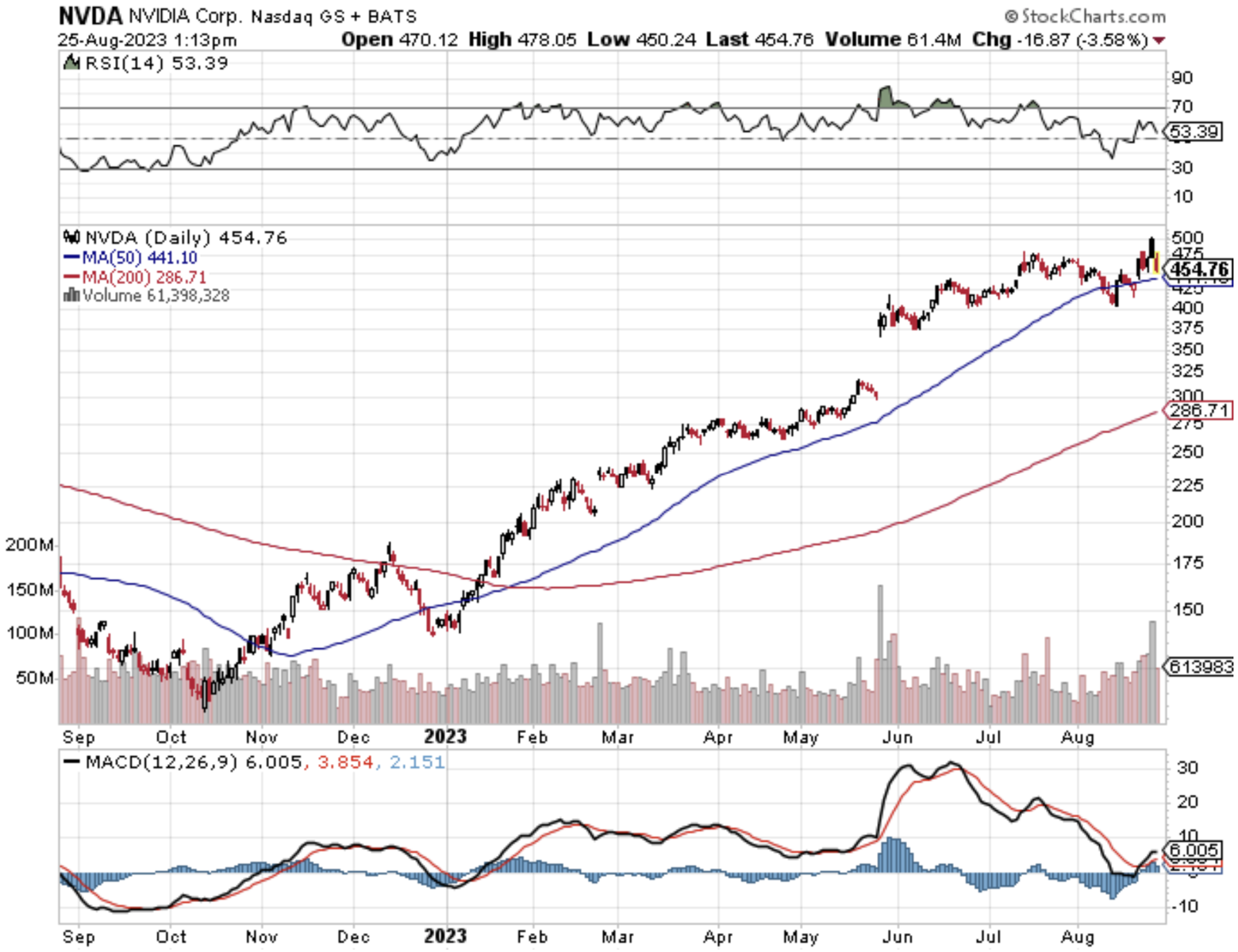
Mad Hedge Technology Letter
August 21, 2023
Fiat Lux
Featured Trade:
(ANOTHER RED FLAG FROM DIGITAL GOLD)
($BTC), ($COMPQ), (TLT)

When good times roll then the digital gold does too.
More often than not, these good times occur when liquidity gates widen.
Simply put, there’s more cash for alternative assets like Bitcoin ($BTC) to speculate on and that’s what people do.
Bitcoin as a standalone asset possesses no intrinsic value and delivers investors zero cash flow which are serious drawbacks in times of pain.
I wouldn’t go so far as to say this is a time of pain right now, but we are inching closer to it as the US 10-year treasury (TLT) hits 4.35%.
Sometimes, investors need that extra little bit of cash flow from that 50-year-old studio tucked away deep inside their portfolio to survive.
Call it a rainy day fund if you will.
The drawdown in Bitcoin is an ominous sign for tech shares ($COMPQ) because the logic goes that if Bitcoin goes up, so does tech.
The narrative for some time has been that Bitcoin is akin to something like crappy tech so if crappy tech shares deliver, then the good tech companies that offer cash flow and software products will do even better.
Bitcoin has just been jolted by some negative price action as we find ourselves lower than last week, at around $26,000 per BTC.
Longer-term US Treasury yields are around multi-year highs, part of a global bond selloff that reflects the risk of a prolonged period of restrictive monetary settings to bring down inflation.
Such a backdrop portends constrained liquidity that would pose a challenge for riskier assets like tech stocks and crypto.
Higher interest rates mean that assets like Bitcoin don’t look so attractive on a relative basis.
Some of the technical signals followed by chart analysts paint a mixed picture. A gauge of momentum known as the 14-day relative strength index suggests Bitcoin is close to the most oversold level since mid-2022.
Other metrics point to a reluctance among retail and institutional investors to engage with crypto following last year’s rout, blowups like FTX, and an ever-shifting regulatory landscape.
For instance, average daily spot volumes on centralized digital-asset exchanges over the past four months were the lowest since October 2020 — when Bitcoin was at about $10,000.
The last 30 days have been brutal for the Nasdaq index and narrowing the goalposts means that BTC will be one of the first casualties to get heaved into the dumpster.
The price action for tech stocks has been highly disappointing lately and there is a strong chance that we could revert to sell the rallies in the short term.
Numerous times the Nasdaq has started the morning hot out of the gate only to suffer sharp sell-offs as the afternoons rolled around.
Shares trending lower to end the trading day have epitomized tech shares lately.
Momentum is lackluster.
The reason I believe that tech shares will endure a harsher period of consolidation is because the added kick in the nuts is China weakness.
Growth forecasts are starting to get ratcheted back as it appears that China has entered the Japan-style lost decade type of slowdown that is a symbol of economic stagnation.
The Nasdaq is really searching hard under each stone to find some type of tailwind to propel us into year-end, but the window is closing quickly. Let’s hope we find that rocket fuel to get us over the line.
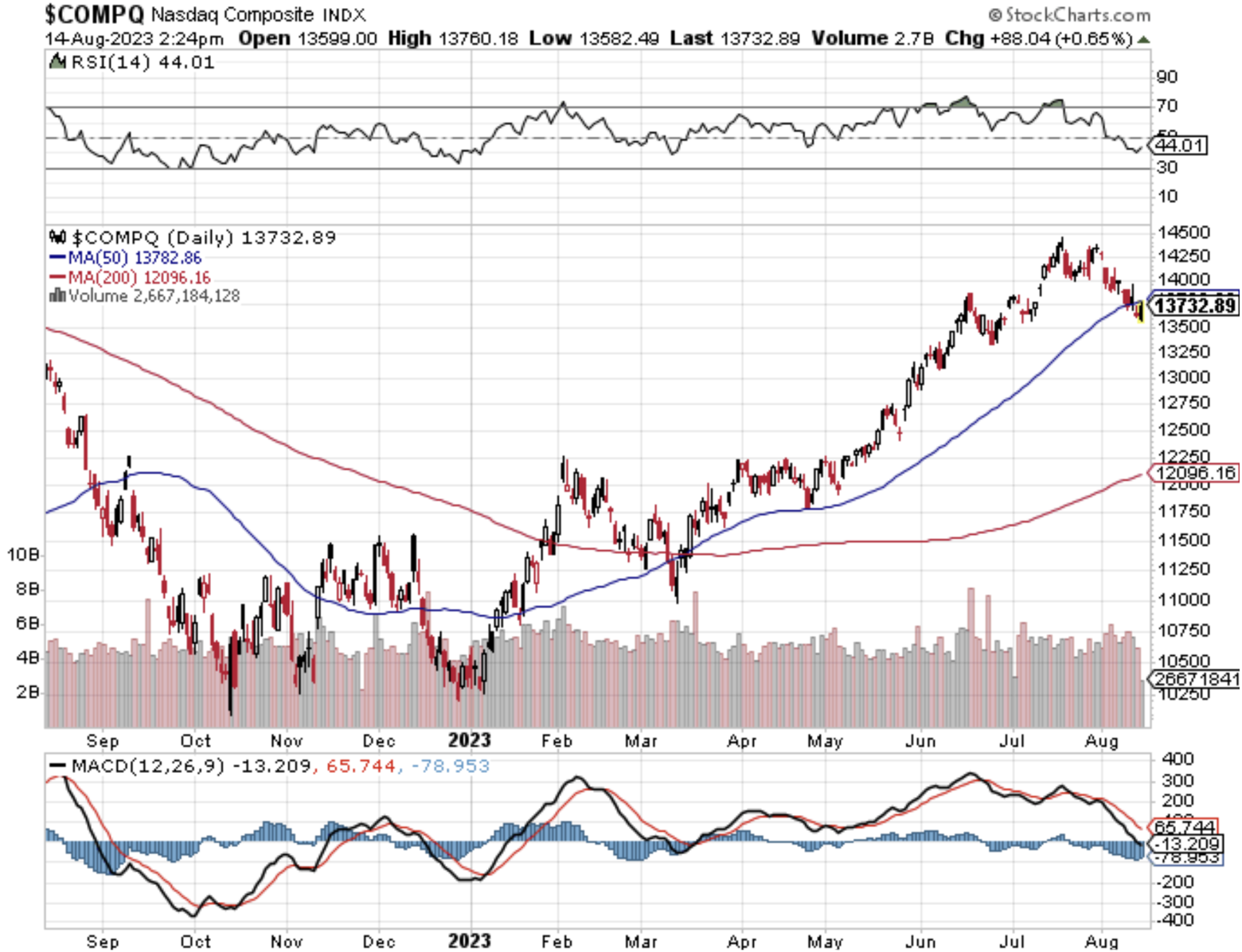
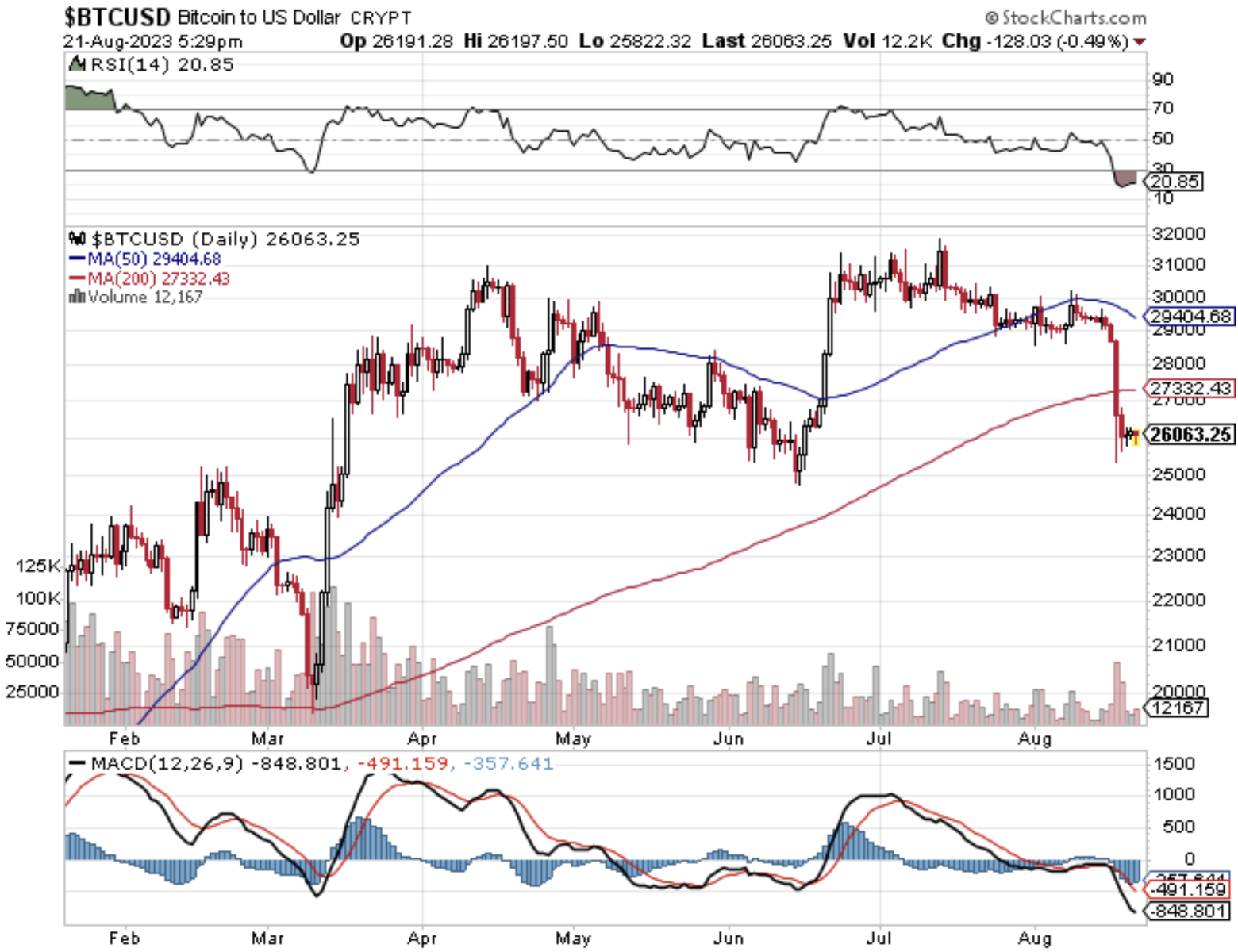
Mad Hedge Technology Letter
August 18, 2023
Fiat Lux
Featured Trade:
(A POOR OMEN)
($TNX), ($COMPQ)

The U.S. 10-year Treasury bond ($TNX) has surged past the October 2022 high so what does that mean for tech stocks ($COMPQ)?
In short term, tech shares will be held back.
Tech stocks are the most exposed to collateral damage from surging interest rates because of the growth nature of the sector.
Funnily enough, much of this 2023 rally has been fueled by the notion of a Fed “pivot” coming down the pipeline.
It still hasn’t come, but now the pendulum has swung the other way and tech shares, even the biggest and best, and getting brutalized.
The people short tech stocks in 2023 couldn’t have been more wrong even if betting against the Fed doesn’t usually work.
Now, the inverse of the Fed pivot is taking place as the U.S. 10-year Treasury bond has hit highs of 4.32% demolishing last years’ peak.
Technically, once recent highs shatter, it is common for set algorithms to motion another wave of money to continue the trend.
The trend for yields is now higher.
It’s highly plausible that this bull market in bond yields picks up and pushes to 5%.
Why is this happening?
The surprisingly resilient US economy has meant the job market is on fire. Tech companies have become leaner, but have abstained from mass firings.
Also, Americans are spending like there is no tomorrow which has kept stocks going up for most of the year and the latest earnings season reinforces this trend.
The result will mean that inflation could remain stubbornly above the Fed’s target, leaving room for long-term yields to push even higher.
There is a remarkable repricing higher in longer-term rates and many traders have been caught off guard.
The market is coming more to the view that there is going to be long-term inflation pressures despite recent progress.
Macro uncertainty is going to remain the story for the next few years, and that requires greater compensation to own long-dated bonds.
But many now expect a soft landing that would leave inflation the dominant risk.
For much of the year, the market worked its way towards a hard landing/Fed pivot scenario which factors in lower inflation. Now the opposite is happening.
Broader economic shifts are also driving speculation that the low rates — and inflation — of the post-crisis period were an anomaly. Among them: surging wage costs, deglobalization, and corporates padding their net margins.
The U.S. is drowning in its own federal debt but must issue more to service the interest on this debt meaning the purchasing power in the United States is crashing.
The net net of this is very negative for technology stocks and it’s a tough pill to swallow after benefiting from the AI bubble and Fed pivot narrative for the first 7 months of the year.
It’s difficult to see another burst of hot money pouring into tech stocks for the rest of 2023.
If we are stuck with the soft landing and the higher for longer narrative, then markets will bid up higher inflation which will suppress tech stocks.
That is what the 4.33% in the 10-year is telling us and tech stocks in the near term will be negatively correlated with this yield moving into the last 3 months of the year.
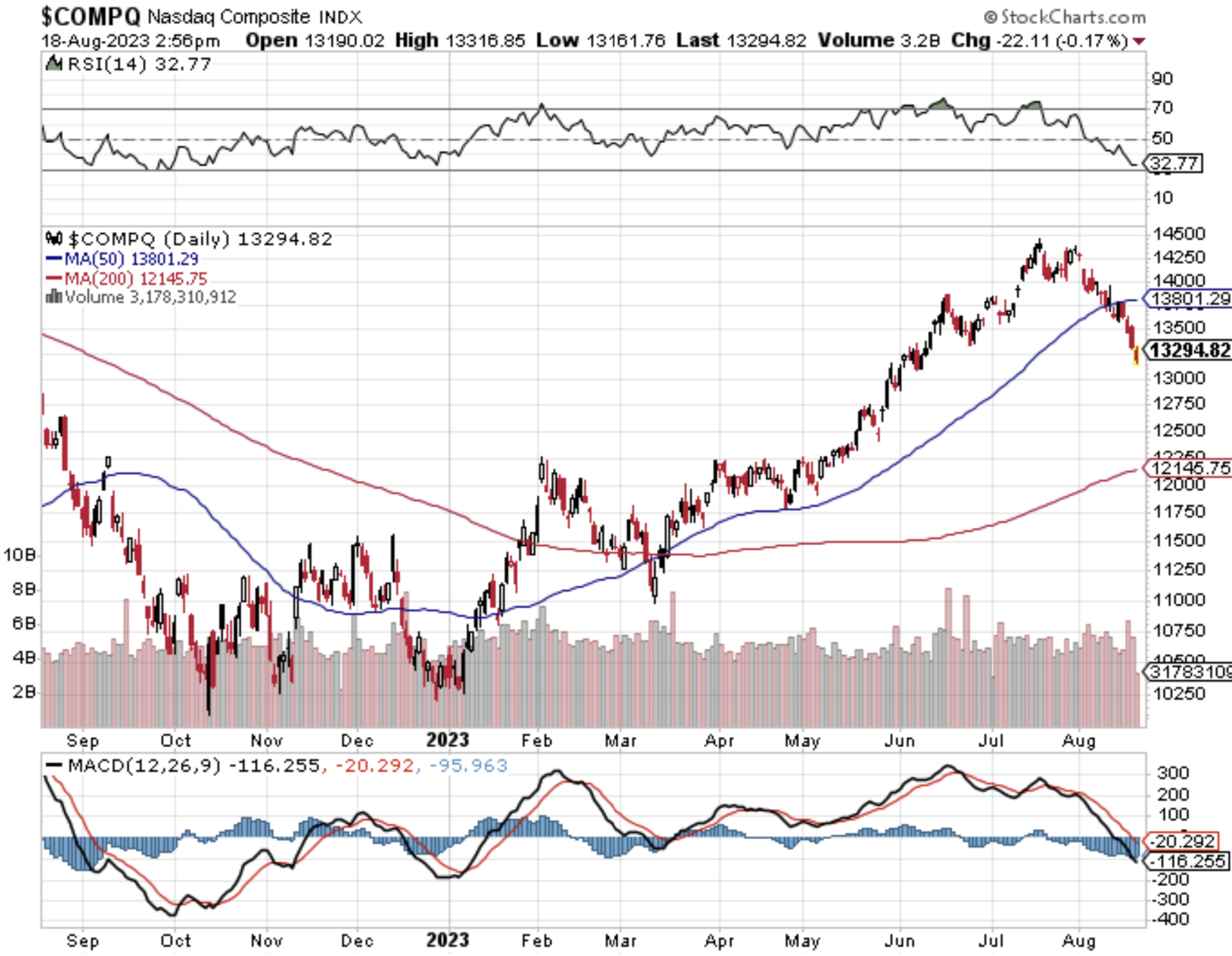
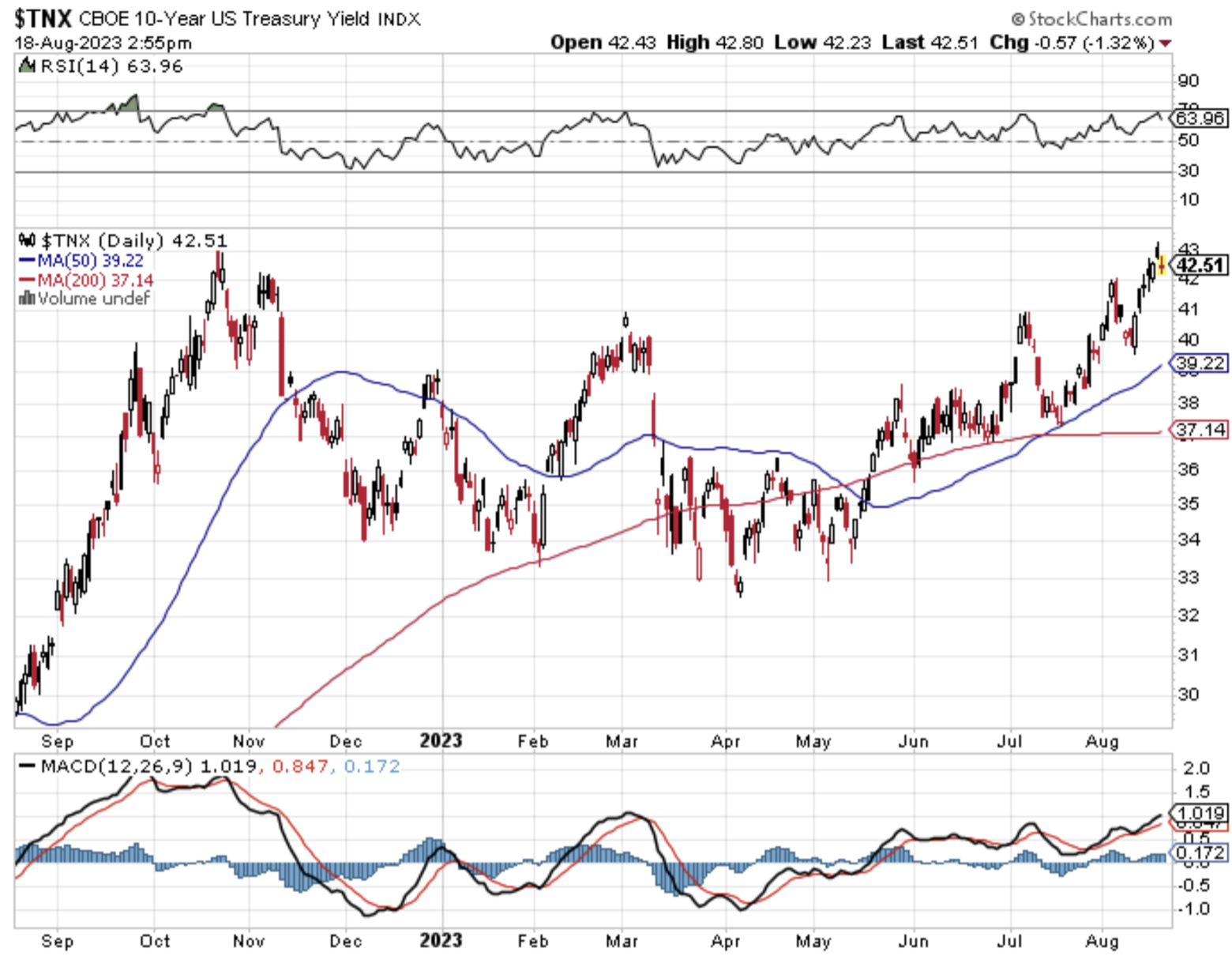
Legal Disclaimer
There is a very high degree of risk involved in trading. Past results are not indicative of future returns. MadHedgeFundTrader.com and all individuals affiliated with this site assume no responsibilities for your trading and investment results. The indicators, strategies, columns, articles and all other features are for educational purposes only and should not be construed as investment advice. Information for futures trading observations are obtained from sources believed to be reliable, but we do not warrant its completeness or accuracy, or warrant any results from the use of the information. Your use of the trading observations is entirely at your own risk and it is your sole responsibility to evaluate the accuracy, completeness and usefulness of the information. You must assess the risk of any trade with your broker and make your own independent decisions regarding any securities mentioned herein. Affiliates of MadHedgeFundTrader.com may have a position or effect transactions in the securities described herein (or options thereon) and/or otherwise employ trading strategies that may be consistent or inconsistent with the provided strategies.
This site uses cookies. By continuing to browse the site, you are agreeing to our use of cookies.
OKLearn moreWe may request cookies to be set on your device. We use cookies to let us know when you visit our websites, how you interact with us, to enrich your user experience, and to customize your relationship with our website.
Click on the different category headings to find out more. You can also change some of your preferences. Note that blocking some types of cookies may impact your experience on our websites and the services we are able to offer.
These cookies are strictly necessary to provide you with services available through our website and to use some of its features.
Because these cookies are strictly necessary to deliver the website, refuseing them will have impact how our site functions. You always can block or delete cookies by changing your browser settings and force blocking all cookies on this website. But this will always prompt you to accept/refuse cookies when revisiting our site.
We fully respect if you want to refuse cookies but to avoid asking you again and again kindly allow us to store a cookie for that. You are free to opt out any time or opt in for other cookies to get a better experience. If you refuse cookies we will remove all set cookies in our domain.
We provide you with a list of stored cookies on your computer in our domain so you can check what we stored. Due to security reasons we are not able to show or modify cookies from other domains. You can check these in your browser security settings.
These cookies collect information that is used either in aggregate form to help us understand how our website is being used or how effective our marketing campaigns are, or to help us customize our website and application for you in order to enhance your experience.
If you do not want that we track your visist to our site you can disable tracking in your browser here:
We also use different external services like Google Webfonts, Google Maps, and external Video providers. Since these providers may collect personal data like your IP address we allow you to block them here. Please be aware that this might heavily reduce the functionality and appearance of our site. Changes will take effect once you reload the page.
Google Webfont Settings:
Google Map Settings:
Vimeo and Youtube video embeds:
